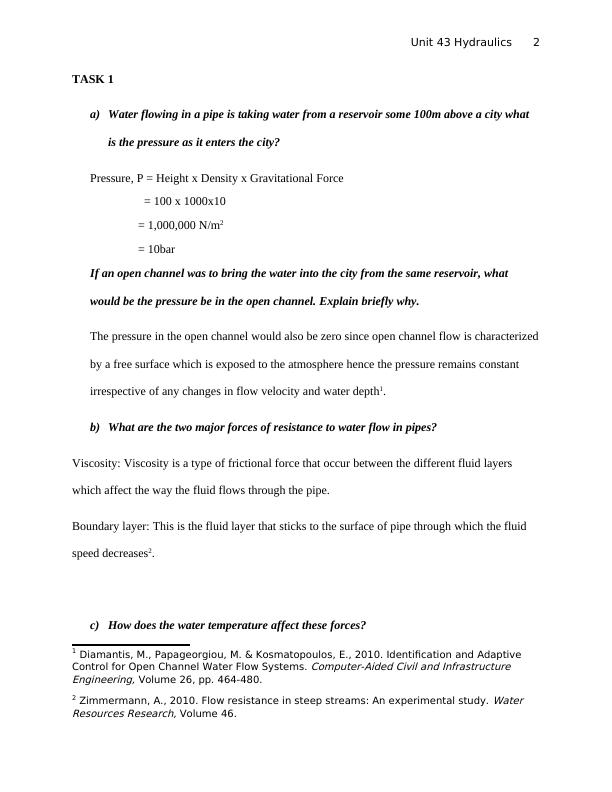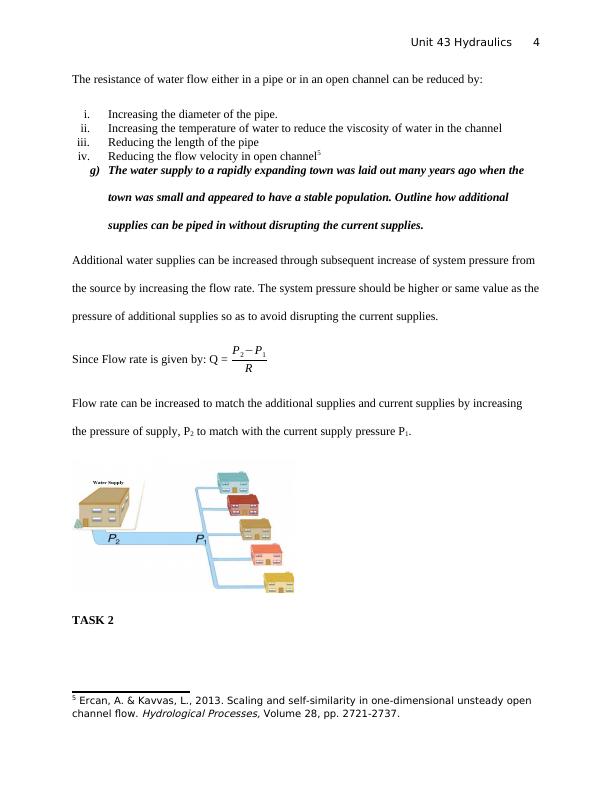Course Instructor Institution Location
13 Pages2113 Words50 Views
Added on 2022-08-12
Course Instructor Institution Location
Added on 2022-08-12
ShareRelated Documents
Unit 43 Hydraulics 1
HYDRAULICS FOR CIVIL ENGINEERING
By Name
Course
Instructor
Institution
Location
Date
HYDRAULICS FOR CIVIL ENGINEERING
By Name
Course
Instructor
Institution
Location
Date

Unit 43 Hydraulics 2
TASK 1
a) Water flowing in a pipe is taking water from a reservoir some 100m above a city what
is the pressure as it enters the city?
Pressure, P = Height x Density x Gravitational Force
= 100 x 1000x10
= 1,000,000 N/m2
= 10bar
If an open channel was to bring the water into the city from the same reservoir, what
would be the pressure be in the open channel. Explain briefly why.
The pressure in the open channel would also be zero since open channel flow is characterized
by a free surface which is exposed to the atmosphere hence the pressure remains constant
irrespective of any changes in flow velocity and water depth1.
b) What are the two major forces of resistance to water flow in pipes?
Viscosity: Viscosity is a type of frictional force that occur between the different fluid layers
which affect the way the fluid flows through the pipe.
Boundary layer: This is the fluid layer that sticks to the surface of pipe through which the fluid
speed decreases2.
c) How does the water temperature affect these forces?
1 Diamantis, M., Papageorgiou, M. & Kosmatopoulos, E., 2010. Identification and Adaptive
Control for Open Channel Water Flow Systems.
Computer-Aided Civil and Infrastructure
Engineering, Volume 26, pp. 464-480.
2 Zimmermann, A., 2010. Flow resistance in steep streams: An experimental study.
Water
Resources Research, Volume 46.
TASK 1
a) Water flowing in a pipe is taking water from a reservoir some 100m above a city what
is the pressure as it enters the city?
Pressure, P = Height x Density x Gravitational Force
= 100 x 1000x10
= 1,000,000 N/m2
= 10bar
If an open channel was to bring the water into the city from the same reservoir, what
would be the pressure be in the open channel. Explain briefly why.
The pressure in the open channel would also be zero since open channel flow is characterized
by a free surface which is exposed to the atmosphere hence the pressure remains constant
irrespective of any changes in flow velocity and water depth1.
b) What are the two major forces of resistance to water flow in pipes?
Viscosity: Viscosity is a type of frictional force that occur between the different fluid layers
which affect the way the fluid flows through the pipe.
Boundary layer: This is the fluid layer that sticks to the surface of pipe through which the fluid
speed decreases2.
c) How does the water temperature affect these forces?
1 Diamantis, M., Papageorgiou, M. & Kosmatopoulos, E., 2010. Identification and Adaptive
Control for Open Channel Water Flow Systems.
Computer-Aided Civil and Infrastructure
Engineering, Volume 26, pp. 464-480.
2 Zimmermann, A., 2010. Flow resistance in steep streams: An experimental study.
Water
Resources Research, Volume 46.

Unit 43 Hydraulics 3
The temperature affects the density of water by decreasing the density when the temperature
increases and increasing the density when temperature decreases. By decreasing the density, the
viscosity and boundary layers are greatly reduced.
d) What is Reynolds Number and how is it related to turbulent flow?
The Reynolds number can be defined as a dimensionless quantity in fluid mechanics used in
predicting the patterns of flow in different situations of fluid flow. At high Reynolds number the
flow tend to be turbulent from differences in the direction and speed of fluids while at low
Reynolds numbers, flows tend to be laminar dominated3.
e) What is the boundary layer and how is it affected by the roughness of the surface over
which water is flowing?
A boundary layer can be defined as a relatively thin fluid layer close to the body surface that is
immersed in the fluid flow. The flow within the boundary layer may be turbulence flow or
streamline flow depending on the distance from the leading edge or particular problem.
If the surface over which water is flowing is smooth, water will have laminar boundary layer
flow since there is no skin friction drag resulting into smooth flow. If the surface over which
water is flowing is hydrodynamically rough over some section of the length there is development
of turbulent boundary layers which affects the mean defect profile and also skin friction4.
f) How is the resistance of water flow reduced either in a pipe or in an open channel?
3 Chamorro, L. & Arndt, R., 2011. Reynolds number dependence of turbulence
statistics in the wake of wind turbines.
Wind Energy, Volume 15, pp. 733-742.
4 Widodo, E. & Pradhana, R., 2018. Analysis of pipe diameter variation in axial
pumps for reducing head loss.
IOP Conference Series: Materials Science and
Engineering, Volume 403\, p. 120.
The temperature affects the density of water by decreasing the density when the temperature
increases and increasing the density when temperature decreases. By decreasing the density, the
viscosity and boundary layers are greatly reduced.
d) What is Reynolds Number and how is it related to turbulent flow?
The Reynolds number can be defined as a dimensionless quantity in fluid mechanics used in
predicting the patterns of flow in different situations of fluid flow. At high Reynolds number the
flow tend to be turbulent from differences in the direction and speed of fluids while at low
Reynolds numbers, flows tend to be laminar dominated3.
e) What is the boundary layer and how is it affected by the roughness of the surface over
which water is flowing?
A boundary layer can be defined as a relatively thin fluid layer close to the body surface that is
immersed in the fluid flow. The flow within the boundary layer may be turbulence flow or
streamline flow depending on the distance from the leading edge or particular problem.
If the surface over which water is flowing is smooth, water will have laminar boundary layer
flow since there is no skin friction drag resulting into smooth flow. If the surface over which
water is flowing is hydrodynamically rough over some section of the length there is development
of turbulent boundary layers which affects the mean defect profile and also skin friction4.
f) How is the resistance of water flow reduced either in a pipe or in an open channel?
3 Chamorro, L. & Arndt, R., 2011. Reynolds number dependence of turbulence
statistics in the wake of wind turbines.
Wind Energy, Volume 15, pp. 733-742.
4 Widodo, E. & Pradhana, R., 2018. Analysis of pipe diameter variation in axial
pumps for reducing head loss.
IOP Conference Series: Materials Science and
Engineering, Volume 403\, p. 120.

Unit 43 Hydraulics 4
The resistance of water flow either in a pipe or in an open channel can be reduced by:
i. Increasing the diameter of the pipe.
ii. Increasing the temperature of water to reduce the viscosity of water in the channel
iii. Reducing the length of the pipe
iv. Reducing the flow velocity in open channel5
g) The water supply to a rapidly expanding town was laid out many years ago when the
town was small and appeared to have a stable population. Outline how additional
supplies can be piped in without disrupting the current supplies.
Additional water supplies can be increased through subsequent increase of system pressure from
the source by increasing the flow rate. The system pressure should be higher or same value as the
pressure of additional supplies so as to avoid disrupting the current supplies.
Since Flow rate is given by: Q = P2−P1
R
Flow rate can be increased to match the additional supplies and current supplies by increasing
the pressure of supply, P2 to match with the current supply pressure P1.
TASK 2
5 Ercan, A. & Kavvas, L., 2013. Scaling and self-similarity in one-dimensional unsteady open
channel flow.
Hydrological Processes, Volume 28, pp. 2721-2737.
The resistance of water flow either in a pipe or in an open channel can be reduced by:
i. Increasing the diameter of the pipe.
ii. Increasing the temperature of water to reduce the viscosity of water in the channel
iii. Reducing the length of the pipe
iv. Reducing the flow velocity in open channel5
g) The water supply to a rapidly expanding town was laid out many years ago when the
town was small and appeared to have a stable population. Outline how additional
supplies can be piped in without disrupting the current supplies.
Additional water supplies can be increased through subsequent increase of system pressure from
the source by increasing the flow rate. The system pressure should be higher or same value as the
pressure of additional supplies so as to avoid disrupting the current supplies.
Since Flow rate is given by: Q = P2−P1
R
Flow rate can be increased to match the additional supplies and current supplies by increasing
the pressure of supply, P2 to match with the current supply pressure P1.
TASK 2
5 Ercan, A. & Kavvas, L., 2013. Scaling and self-similarity in one-dimensional unsteady open
channel flow.
Hydrological Processes, Volume 28, pp. 2721-2737.

End of preview
Want to access all the pages? Upload your documents or become a member.
Related Documents
Unit-43-Hydraulics Tasks 2022lg...
|15
|2390
|8
Physics Assignment-2 | Task Report | Doclg...
|7
|1296
|35
Hydraulics for Civil Engineeringlg...
|11
|1470
|27
Hydraulics for Civil Engineering Assignmentlg...
|15
|2730
|12
Physics Assignment | Task Report | Doclg...
|8
|1453
|21
Fluid Mechanics for Chemical Engineeringlg...
|8
|1735
|11
